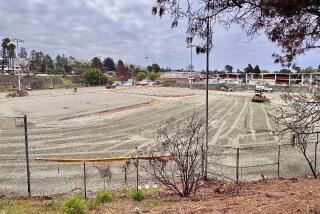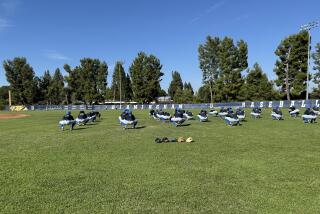Making the Most of Very Little : USIU Players Turned Mini-Canyon Into Their Field
- Share via
SAN DIEGO — A couple of years ago, when players Ron Green and Ted Rivenbark took a look at what was going to be their new baseball field at United States International University, they squinted and asked: “Where?”
Someone pointed out to them, and the rest of the Gull baseball team, that the muddy, rock-infested field situated at the foot of a canyon on the northeast side of campus would be home to their hitting, pitching and fielding.
The land USIU had allocated for the construction of the new field, which was recently made playable, resembled a dried, rocky river bed instead of a college-level baseball facility. But the Gulls had a choice--take the Grand Canyon’s little cousin, or keep playing their home games at other schools.
“When I first saw it, I didn’t think it could be a field,” said Green, an outfielder. “There was just a bunch of rocks all over the place when I first came out here.”
That sight would be enough to frustrate any player when told he would have to someday attempt to field a hard-hit ground ball on that surface.
But try telling that same athlete that he would be the one who would have to transform the beaten up terrain into a lush green outfield and level infield. It was like trying to turn a gravel pit into a PGA-approved putting green.
That was the task Gull Coach Al Everest was left with when he made the decision in 1982 to turn the worthless parcel of real estate into the new home for his team. But oddly enough, he had a relatively easy time replacing his players’ bats and mitts with shovels and work gloves.
“It was kind of strange at first,” Green said. “I’ve never played on a baseball team where you had to come out with shovels and rakes and rake rocks.”
The Gulls now have their baseball field, aptly named Players’ Field, and it’s hard to tell that the site once was home to a crop of weeds and softball-sized rocks.
There was more behind Everest’s motivation to install the ballpark than just having a nice place for his team to play. The Gulls were spending their practice sessions on the campus soccer field, which is not made to accommodate baseball teams of college caliber.
“You need to have enough time and resources in Division I baseball to do everything you can to be the best,” Everest said. “When you use another school’s facilities, you are at the mercy of them. If I was going to coach this team, I was going to have to have a facility.
“It would be hard to have a good swim team without a swimming pool.”
Everest, 35, and the players, evenly divided among those on full and those on partial scholarships, spent nearly every day of the past four years on the project. Even players who have graduated come back to add the finishing touches.
Today, the field is nestled in the same rocky canyon, surrounded by the same eucalyptus trees, yet the infield ranks among the area’s best. Its infield contains the same mixture of ingredients as the one at San Diego Jack Murphy Stadium. The outfield still has some rough patches, but it has come a long way from its original form.
When other teams were working on the fundamentals of baseball, the Gulls were acting more like a grounds crew, planting grass and digging irrigation ditches.
“Working on the field was our weight workout,” Green said with a laugh.
Everest is credited by players and parents as being the workhorse behind the project.
“Some days in the summer, I would do as much as I could while there was sunlight,” he said. “From meeting trucks at 7 a.m., to going as far as I could until the sun went down.
“My dad teases me, saying that I never even mowed the lawn when I was a kid, and now I’m out here doing hard labor.”
A Highway Department bulldozer removed a hill that extended from the second-base area to behind the center-field fence.
With that out of the way, and with a little help from a handful of local organizations and some of the players’ parents donating their resources and materials at little or no cost, the team installed an elaborate underground drainage system that runs under the infield, a sprinkler system, fencing, dugouts and all of the grass.
There’s still a long way to go, though. More of the outfield grass is coming in each day, with areas in right field covered with patches of artificial turf. Lights, a clubhouse, scoreboard and improved seating are in the plans.
Everest estimated the entire cost of the field hovered near $60,000--much less than what a private contractor would charge for the same job.
Building the field has done more than just provide the Gulls with a place to play.
“Not only do we have a better facility, but now we will have an easier time recruiting players,” said George Kachigian, Gull assistant coach. “It’s tough to recruit Division I-level athletes without good facilities.”
It also brought the players closer together, and gave them an opportunity to get to know one another away from baseball, Everest said.
“It showed us who works hard and who you can count on when the going gets tough,” Green added.
The players’ long hours working on the field has given a new meaning to the phrase “home field advantage.”
“There’s a lot of bounces and rocks out there that no other people will know about except us,” Green said.
Before practice and games, the players continue to work on their field every day, and they say they never felt like quitting, even in the sweltering summer heat.
“We never felt like giving up, because we had a goal,” Gull pitcher Sean Rydell said. “Everybody is happy to be out here and it’s getting better every day.”
When the last blade of grass pushes its way through the ground and the lights are in working order, what will Everest and gang do with all the free time?
“Once it’s all over, I’m turning on the sprinkler and firing the mowers up and that’s it,” he said.
More to Read
Go beyond the scoreboard
Get the latest on L.A.'s teams in the daily Sports Report newsletter.
You may occasionally receive promotional content from the Los Angeles Times.










